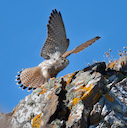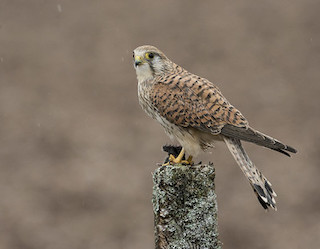 Kestrels, with their narrow wings and long tails, can often be seen over The Lizard.
Kestrels, with their narrow wings and long tails, can often be seen over The Lizard.
Photo: © Richard Birchett
Scientific name: Falco tinnunculus
Other names: European Kestrel, Eurasian Kestrel, Old World Kestrel, Common Kestrel, Windhover.
Cornish name: Tigry
Conservation status: UK Conservation Status, Amber
 When you spot a bird of prey hovering patiently over a roadside verge or field, maintaining its position even in the wind, then it is going to be a Kestrel, waiting to dive and catch some unfortunate small mammal or bird that it has spied in the vegetation.
When you spot a bird of prey hovering patiently over a roadside verge or field, maintaining its position even in the wind, then it is going to be a Kestrel, waiting to dive and catch some unfortunate small mammal or bird that it has spied in the vegetation.
This beautiful raptor can be found in a wide variety of lowland habitats other than roadsides, including farmland, marshland, the coast, heaths, and urban areas. They are distributed across Britain, and their global distribution is wide, including Europe, North Africa, India and China.
Kestrels are easy to recognise in flight by their narrow wings and long tails compared to other native raptors of a similar size. Females are larger than the males, which is common in raptor species, but, less commonly, there are other differences in their appearance. The male is distinctive for the single black band at the end of its grey tail, the black ‘moustache’ marking on its grey head, and rufous-coloured upper parts. In contrast, females have brown heads and brown, barred, upper parts, and several dark coloured bands on their tails. The females are also larger than the males. Seen from below, both sexes have paler undersides. The photograph on this page is of a female.
 Kestrels will eat small birds as well as small mammals, such as voles, and also eat invertebrates, including earthworms, an important source of food in winter. They have exceptionally good eyesight and can see ultra-violet light: this means they can use rodents’ urine trails, which glow at ultra-violet wavelengths, to lead them to their burrows.
Kestrels will eat small birds as well as small mammals, such as voles, and also eat invertebrates, including earthworms, an important source of food in winter. They have exceptionally good eyesight and can see ultra-violet light: this means they can use rodents’ urine trails, which glow at ultra-violet wavelengths, to lead them to their burrows.
A pair will raise one brood per year, laying their eggs in the spring in trees or old buildings. Both parents hunt for food for their young, until they fledge about a month later.
Although one of our most common birds of prey, and certainly the most common of those that hunt during the day, there are threats to Kestrel populations. Although populations now seem to be stable (c. 45,000 pairs in Britian; source, BTO), there was a major decline in the 1970s (the usual culprits of habitat loss and agricultural intensification are the most likely causes, as well as the use of organochlorines in pesticides in the mid-twentieth century that affected many birds).
Did you know…?
…Stocking the larder: when there is plenty of prey, Kestrels will store food for future consumption.
…Heading south: the Kestrel is resident in Britain, but some birds also migrate here in the autumn from Scandinavia and northern Europe.
More information and references:
Gooders, J. and Harris, A., 1986. Field Guide to the Birds of Britain and Ireland. Kingfisher Books, London.
Published: November 2013
Author: Amanda Scott
Photo: Upper, © Natural England/Julian Dowse; lower, © Richard Birchett (website and YouTube)
